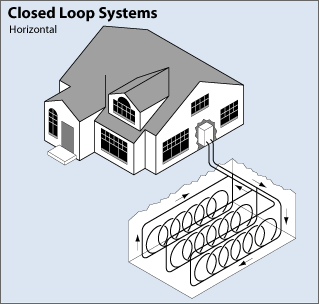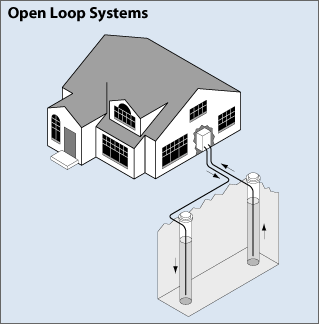What is a ground source heat pump (GSHP)? A heat pump is an air conditioner that can cool in the summer and heat in the winter. The ground source part means that the heat removed from the building in the summer and the heat added to the building in the winter goes to and comes from the ground.
 Ilustration of a horizontal closed loop system shows the tubing leaving the house and entering the ground, then branching into three rows in the ground, with each row consisting of six overlapping vertical loops of tubing. At the end of the rows, the tubes are routed back to the start of the rows and combined into one tube that runs back to the house.
Ilustration of a horizontal closed loop system shows the tubing leaving the house and entering the ground, then branching into three rows in the ground, with each row consisting of six overlapping vertical loops of tubing. At the end of the rows, the tubes are routed back to the start of the rows and combined into one tube that runs back to the house.

Illustration of an open loop system shows a tube carrying water out of the house, into the ground, and over to a well, where it discharges into the groundwater. A separate tube in a well some distance away draws water from the well and returns it to the house.
(Images: EnergySavers.gov)
What’s a renewable resource? Merriam Webster defines it as a resource “capable of being replaced by natural ecological cycles or sound management practices.” Sounds accurate to me!
So why the question?
Governments and utilities often provide financial incentives for equipment or system approaches that are more efficient than code minimum requirements. Those incentives are usually based on the efficiency difference (or energy use difference) between the efficient case and the code minimum case. For example, code might require a boiler that’s 84% efficient. If you install a 94% efficient boiler, you may get a rebate based on the 10% efficiency difference. In the case of renewables, like solar photovoltaics (PVs), the incentives are based solely on system cost since there is no “baseline” to compare to and those incentives are often much higher as a percentage of cost than an “efficiency upgrade” incentive.
Recently, I’ve been party to lot of conversation around this topic with many folks coming down on the side of GSHP systems being renewables. I don’t believe that they are.
Why Aren’t GSHPs renewables?
GSHP systems, because they use a compressor just like an air conditioner does, require an electrical input to function. Very well designed systems will require one unit of energy input to move between three and five units of energy between the building and the ground. That’s an input of between 20% and 33% of the total energy transferred. If you want to go further, figure in the inefficiencies of generation and transmission and that percentage goes way up.
Where does that electrical energy come from? The US Energy Information Administration (EIA) notes that in 2010 89% of the electricity on the US grid came from fossil fuels, coal or nuclear power – none of which are renewable resources, and all of which have a significant environmental impact when extracted, used, and disposed of. The EIA predicts that number will be 84% in 2035; not much different 25 years later. So on average, currently 89% of the electrical power required to operate a GSHP system in the US is from non-renewable sources. Of course, your specific locale or building may have a different energy source profile which certainly warrants consideration. For example, I live in Burlington, Vermont. We’ve got a wood-chip power plant that has a maximum capacity large enough to power nearly the entire city according to the Burlington Electric Department. Realistically, it does not always operate at maximum capacity nor does it always burn wood chips, but assuming it provides just half the city’s needs on average means Burlington’s renewable power profile is significantly different than the nationwide average. Or, you may simply cover your entire building with PVs which will change that source profile as well.
Why THIS MATTERS
GSHP systems, when designed correctly, are typically more efficient that other, traditional systems because of the ground coupling. Ground temperatures are relatively constant throughout the year and in cooling season are lower that the ambient air temperature and in heating season, higher. Rejecting heat to a cool medium and extracting it from a “warm” one makes for a more efficient refrigeration cycle. They’re also usually more expensive than traditional systems due to the ground coupling which typically entails drilling wells that can be 400 to 500 feet deep each (for certain types of systems), or other similar means of ground coupling – all of which require long lengths of pipe and site work that are both in excess of what a traditional system would require. But because they’re more efficient, utilities and governments will provide incentives to owners to help offset the added cost.
It’s true that GSHP systems are potentially more efficient, and they deserve to be incentivized, just like the example above of the more efficient boiler. But truly renewable energy sources – wind, solar, geothermal, hydro, biomass – should be incentivized at higher relative rates than more efficient systems that do not use renewables. A higher incentive for renewable energy sources will serve to further encourage their implementation.
Related
What are Geothermal Heat Pumps and How Do They Work? - FurnaceCompare.com


